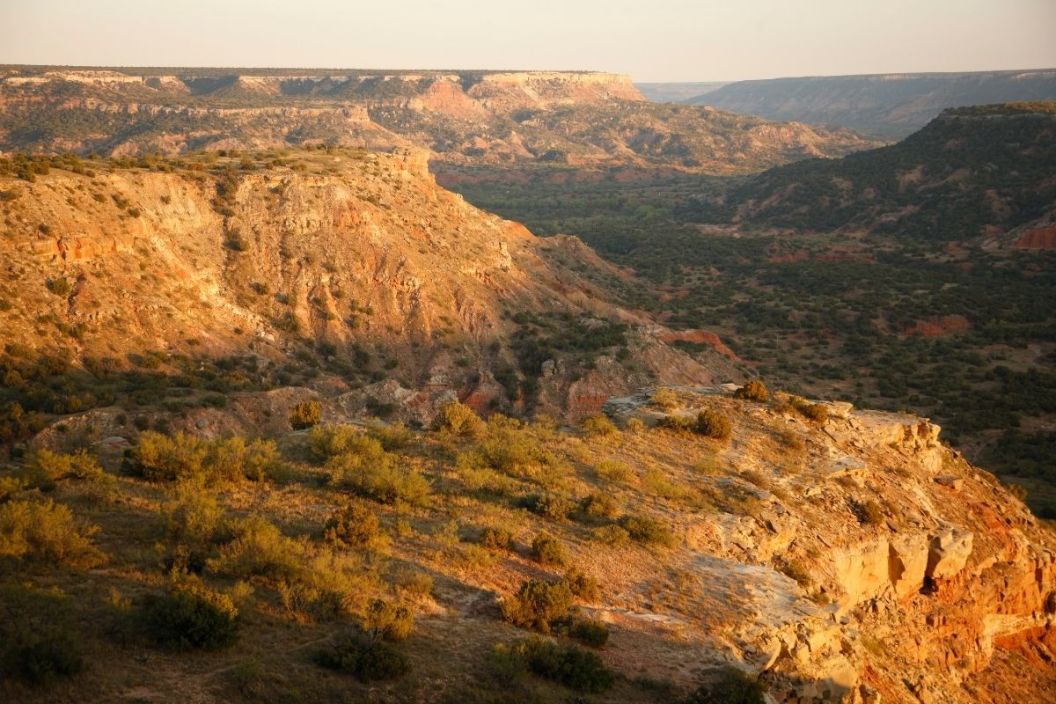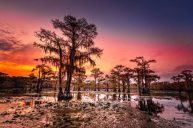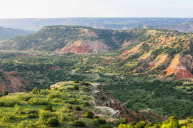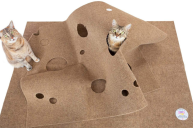My friend and I were planning a camping trip, and since visiting Arizona's Grand Canyon was about out of our reach, we decided to check out Palo Duro Canyon, the second largest canyon in the U.S. We wanted to explore and adventure through a calmer place that wouldn't be so crowded with people in late May, and visiting "the Grand Canyon of Texas" was the perfect choice for us Texans.
Traveling to Palo Duro Canyon State Park was simple for us because we loaded up my friend's car with two days worth of necessities and drove across the vast farm lands that make up Central and West Texas. The drive itself was pretty uneventful and straightforward, but it was the calm we needed before the unpredictable storm we encountered near the end of our trip.
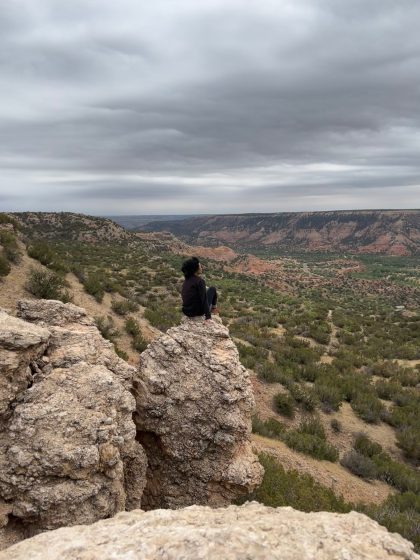
Image by Lauren Pineda
The day before we started our journey, we discovered there were flash flood warnings in the Palo Duro area set for the same time as our camping reservation. Digging into our inner meteorologist, we tried to gauge the weather radar, attempting to avoid the storm by leaving a few hours later than our originally planned time.
By the time we arrived at the park, the sun began to set. The entrance had closed early that day for maintenance, but still our check-in went smoothly. I had called that afternoon to let the park rangers know that we were arriving late, and they gave us the park gate code to enter. They also left our information packet in a yellow mailbox on the side of the headquarters.
There's a road called Park Road 5 that runs through the entire canyon and back, and you can access all camping areas and trailheads along its path. It's a 16-mile long round-trip that takes visitors from the canyon rim down to the floor, where big rocks, trees, and brush take up all the space in-between the sides of the road and the canyon wall. The road crosses a few small bridges that sit above dried up creeks, before looping back and ascending again at its end by the Visitor Center.
We started our descent on Park Road 5, carefully driving down 800 feet from the rim with the canyon wall on our left and the road's cliff edge on our right. We looped around the bumps and wrinkles that protrude from the canyon side, and a transcendence hit as the sun traveled deeper into the Earth with us. The shadows of the canyon sides began to tower over us, making us realize how small we are. Since our camping reservation was for Sunday-Tuesday, there were even less cars and people around than we expected. And by the time we arrived at our campsite, everything around us grew darker.
Car Camping at Palo Duro Canyon State Park
Reserving camping at Palo Duro Canyon State Park is pretty easy, and we met a couple digital nomads who had arrived at the same time we did for first-come, first-serve camping. I made our reservation on the Texas State Park website just a month prior to our trip, and there were a decent amount of openings that ranged from cabins, campsites with electric hookups and/or water hookups, group campsites, group halls, and even a pavilion that can hold up to 54 people in a group. My friend and I stayed at the Fortress Cliff Camp Area, a campsite with a water hookup that lies deep in the middle of the canyon in between campgrounds near the entrance such as the Sagebrush and Hackberry Camp Areas and campgrounds near the end of the park such as the Cactus, Mesquite, and Juniper Multi-Use Camp Areas.
We picked the Fortress Cliff Camp Area because we only needed a water hookup since we planned to sleep in the car, wanted to camp deep in the canyon, and be near the biggest cluster of hiking trails. Palo Duro Canyon also offers mountain biking, equestrian, and other multi-use trails, but we were only interested in hiking. Our camp area had reasonably spaced campsites, two big trash bins, and two porta potties. The canyon wall is a nice backdrop, so we were able to enjoy our meals and downtime while admiring the red rocks that overlooked us.
Each campsite has a picnic area and shade shelter- one that we didn't think we would eventually have to take cover under. We hadn't encountered any rain on our way to the park, and thankfully the radar kept pushing back the time for when this huge storm was predicted to hit us. We hoped that it would remain that way for the rest of our trip, but if you know anything about Texas weather, you know better than to believe that. We didn't realize how glad we would eventually be that we were not sleeping in a tent.
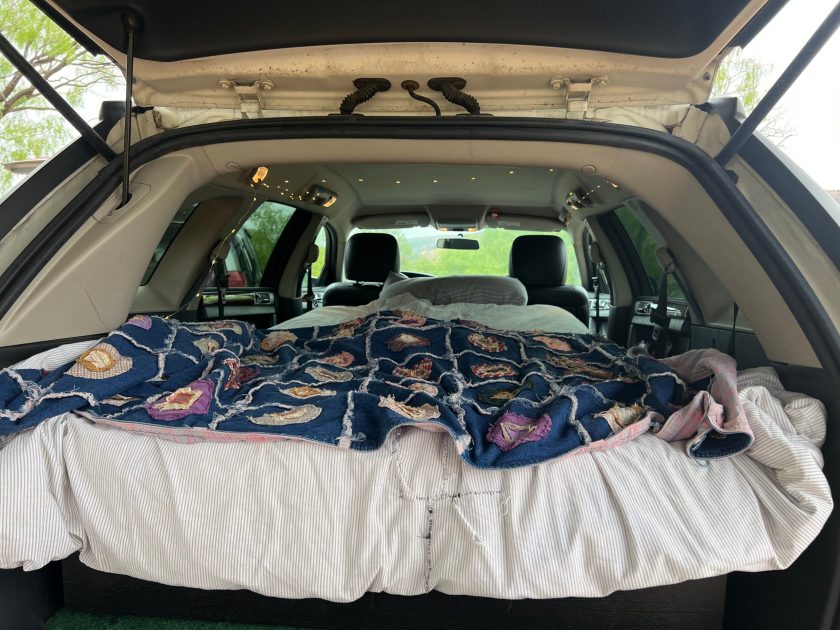
Image by Lauren Pineda
We drove my friend's Chrysler Pacifica to Palo Duro because she transformed the back of the car into a portable sleeping area. She removed her two back seats and screwed down two detachable platforms: the bottom one used as a storage shelf and the top one as the bed frame we slept on. Underneath the bottom platform was a big drawer that held everything we would need for camping: a camping stove, two propane gas tanks, pots and pans, bowls, cooking and eating utensils, a cutting board, trash bags, extra towels, a first aid kit, and a travel-sized tool kit. The top platform had a sleeping pad, a comforter, and two blankets and pillows for us to comfortably rest. In front of the structure, there was a space before the two front seats where we put our cooler full of ice for our food, a big jug filled with enough fresh water to last both of us the next two days, and our duffel bags for our clothes and toiletries. By the sound of all of this, you would think we were plenty prepared to camp. What could possibly go wrong?
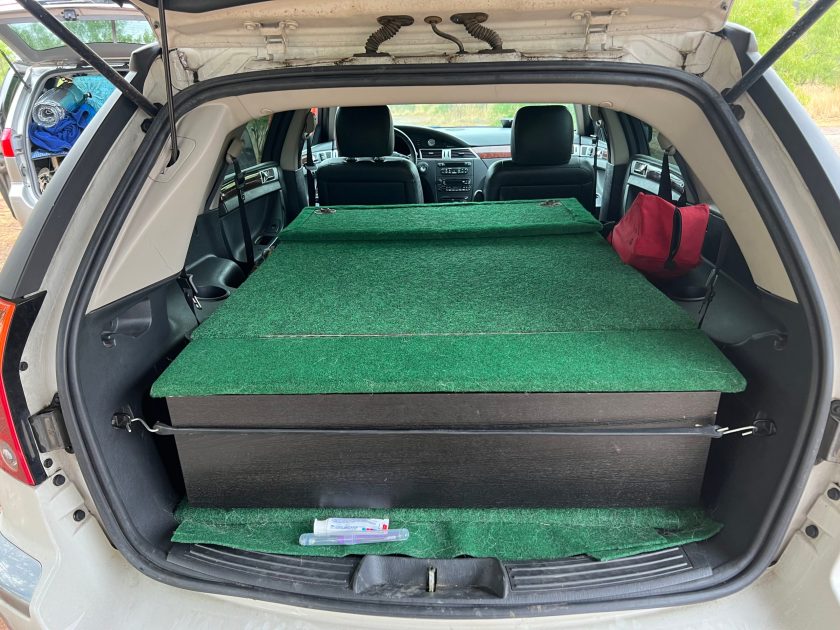
Image by Lauren Pineda
By the time we pulled into our campsite, the night sky was beautifully littered with stars. My friend and I excitedly started setting up for a late dinner but encountered another problem to solve. After multiple attempts at attaching our new propane tanks to the gas hose of our portable camp stove, we realized that something was broken and that we wouldn't be able to make dinner that night. We resorted to just eating the snacks we did have before calling it a night, figuring we could ask neighboring campers to help us out in the morning.
RELATED: How to Put Together an Always-Ready Camp Kitchen
Hiking Palo Duro Canyon
When daylight woke us, we stepped out of the car and were slapped by early-morning cold winds. I borrowed an extra sweater my friend happened to bring, because I mindlessly packed only leggings and t-shirts for the hot Texas weather that comes in May, even when there's a thunderstorm. The campsite next to us was occupied by a sweet Canadian family with an endlessly curious little boy who only spoke French. They graciously allowed us to use their camp stove to cook our breakfast, and we learned that they were in the middle of an amazing four-month long road trip across the U.S. They had stopped in Palo Duro to rest for a few days before making another long drive to their next destination and were supposed to move campsites because their reservation was up. As a thank-you for allowing us to use their camp stove, we invited them to share our campsite. We helped them move their stuff over to set up our little community campground and then set out to go hike.
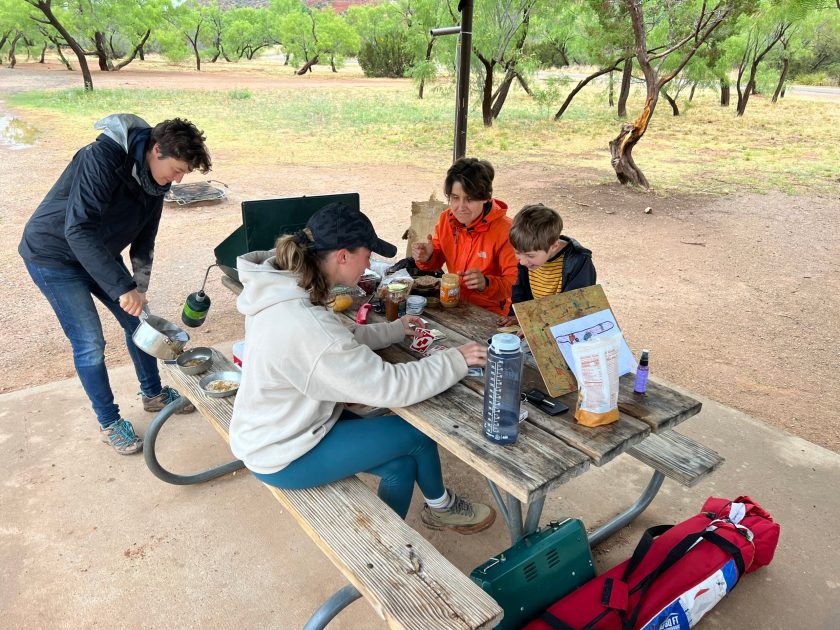
Image by Lauren Pineda
RELATED: 5 Easy & Tasty Camping & Van Life Meals
Our plan was to hike Rock Garden Trail first because we wanted to check out the views from the canyon rim. We were then supposed to hit the Sunflower and Rojo Grande Trails next because those were just a few steps away behind our camp area. We would then check out the famous Lighthouse Trail the next morning before our check-out time at noon, because it's one of the easier hikes in the park. We thought that seeing the iconic Lighthouse formation on that trail would be a great ending to our trip.
Rock Garden Trail
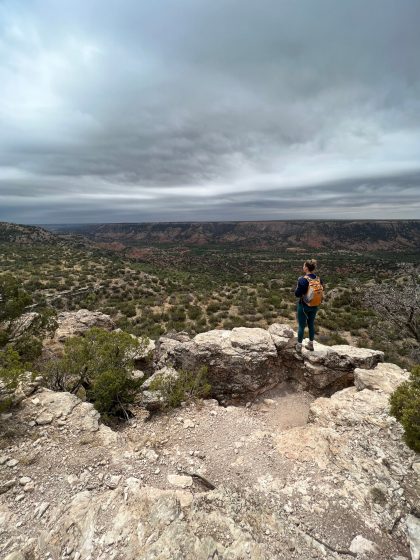
Image by Lauren Pineda
The sky was overcast and gray, but the weather was cool and ideal for hiking. Rock Garden Trail is a 2.39-mile trail that is a steep hike from the canyon floor to the rim. The first half of the hike was simple, just uphill steps until the trail meets the Comanche Trail coming from the other side. From there, it traverses across the canyon wall until you reach the top of the rim. But the hike along the canyon wall wasn't just a way to get to the top. What was super interesting about this part of the hike was all the incredible rock structures that had naturally formed over time along the way. The water that once rushed through the canyon created fascinating striations and formations on the rocks, and the different sediments that were moved by erosion and weathering formed vibrant colors of red, green, blue, purple, and yellow that layered on top of one another the higher we hiked.
Rock Garden Trail ends at the top of the canyon, but away from the cliff's edge. My friend and I decided to get on the Rylander Fortress Cliff Trail that meets the end of Rock Garden Trail and follow it to the edge of the canyon where we could see the entire area. And the view was absolutely breathtaking.
Unbound by time constraints, we decided to follow Rylander Fortress Cliff Trail along the edge of the canyon cliff. I was amazed at how although it seemed like we were able to see everything in the state park from such a high point-of-view, every time we moved along the new trail, we would see more and more details of the canyon that you could only see at specific vantage points. Another great aspect of hiking this trail was that it wasn't crowded at all, and we saw only less than 10 people the entire time we hiked.
By the time we decided to head back to fuel up before our next hike, we were delighted in thinking that it was no longer going to rain. The sun was out, and the weather was nice and warm. So we took our time making our way down the canyon because, again, there was so much to see from the different perspectives we didn't catch on our way up. Because we were facing the other side of the canyon, we could see the Big Cave, an opening in the canyon wall. When we made it back to camp, our new friends were cooking a late lunch and offered some to us. But as we sat and ate with them, discussing our adventures for the day, the sky suddenly darkened and rain clouds came running in. The storm had finally arrived, and it was ready to pour.
When It Rains, It Pours
We quickly made sure our valuables were stowed away, but as it started heavily raining, we discovered that we didn't need to take refuge in our cars. The shade shelter that sits over the picnic table covered us enough to where we could sit outside and enjoy views of the storm without freezing from getting wet. The dirt around our campsite became a muddy flood, but what was awesome about viewing Palo Duro Canyon in the rain was that the rainwater saturated the colors that layered the canyon walls. So even though we could no longer hike, we were still able to behold wonderful views of the area.
We spent the rest of the night drinking hot tea and learning more about our new friends. They shared the adventures they experienced coming from the Northeast and told us fascinating stories of when they traveled to Asia for six months, visiting Nepal, Thailand, and the Philippines. The storm raged on throughout the night and morning until it was time for us to leave. Even though the rain calmed down for a second, the park still unfortunately closed down all the trails because of the flooding. The rain followed us home as we left the Texas panhandle, but even though we didn't get to see everything we thought we would, it didn't feel like we missed out on anything.

Lauren Pineda is based in Austin, Texas, and found her love for writing in local music journalism. She now enjoys writing about all the hilarious mishaps and adventures that happen when traveling somewhere for the first time and prides herself on being a budding traveler with an ambitious drive to learn more about the places she visits. Instagram: @lt.jpeg
READ MORE: How to Find the Best Camping in National Parks and Forests
